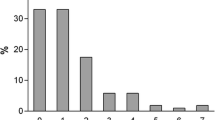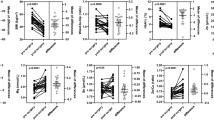Abstract
Background
The aim of this study was to compare serum levels of trace elements in morbidly obese female patients seeking bariatric surgery with those of age-matched females with body mass index (BMI) less than or equal to 30.
Methods
Blood samples were collected from 66 morbidly obese female patients seeking bariatric surgery prior to undergoing surgery. Blood was collected also from 44 female patients (with BMI less than or equal to 30) prospectively from April 2009 till February 2010. Exclusion criteria in both groups were the presence of any co-morbidities on medication, patients receiving any vitamin supplement or any herbal product intake, smoking, and alcohol consumption. Serum zinc, magnesium, copper, and selenium were measured and compared between the two groups.
Results
The mean age and BMI for morbidly obese female patients was 28.5 years (21.5–35.5) and 45.26 kg/m2 (40.3–50.22). The control group had a mean age and BMI of 30.75 years (21.35–40.15) and 25.88 kg/m2 (22.73–29.03). For morbidly obese patients, the serum level of copper, zinc, selenium, and magnesium was 1,623.84, 698.34, 86.08, and 17,830 μg/l, respectively, compared to 1,633.36, 734.82, 101.14, and 18,260 μg/l for the control group. The serum levels of the trace elements were not statistically significantly different between the two groups except for selenium, which was significantly reduced among morbidly obese female patients (p < 0.0001).
Conclusions
Serum selenium level is significantly reduced among morbidly obese female patients seeking bariatric surgery.
Similar content being viewed by others
References
Deitel M. Overweight and obesity worldwide now estimated to involve 1.7 billion people. Obes Surg. 2003;13:329–30.
Wittgrove AC, Clark GW, Tremblay LJ. Laparoscopic gastric bypass, roux-en-y: preliminary report of five Cases. Obes Surg. 1994;4:353–7.
Pope GD, Birkmeyer JD, Finlayson SR. National trends in utilization and in-hospital outcomes of bariatric surgery. J Gastrointest Surg. 2002;6:855–60. discussion 861.
de Luis DA, Pacheco D, Izaola O, et al. Clinical results and nutritional consequences of biliopancreatic diversion: three years of follow-up. Ann Nutr Metab. 2008;53:234–9.
Griffith DP, Liff DA, Ziegler TR, et al. Acquired copper deficiency: a potentially serious and preventable complication after gastric bypass surgery. Obesity (Silver Spring). 2009;17:827–31.
Chan S, Gerson B, Subramaniam S. The role of copper, molybdenum, selenium, and zinc in nutrition and health. Clin Lab Med. 1998;18:673–85.
Lopes PA, Santos MC, Vicente L, et al. Trace element status (Se, Cu, ZN) in healthy Portuguese subjects of Lisbon population: a reference study. Biol Trace Elem Res. 2004;101:1–17.
Ghayour-Mobarhan M, Taylor A, Lamb DJ, et al. Determinants of serum copper, zinc and selenium in healthy subjects. Ann Clin Biochem. 2005;42:364–75.
Ghayour-Mobarhan M, Shapouri-Moghaddam A, Azimi-Nezhad M, et al. The relationship between established coronary risk factors and serum copper and zinc concentrations in a large Persion cohort. J Trace Elem Med Biol. 2009;23:167–75.
Tungtrongchitr R, Pongpaew P, Phonrat B, et al. Serum copper, zinc, ceruloplasmin and superoxide dismutase in Thai overweight and obese. J Med Assoc Thai. 2003;86:543–5.
Bang RL, Mattapallil AB, Dashti HM, et al. Thermal injury and changes in trace elements. J Trace Elem Exp Med. 2000;13:255–64.
Kuczmarski RJ, Carroll MD, Flegal KM, et al. Varying body mass index cutoff points to describe overweight prevalence among U.S. adults: NHANES III (1988 to 1994). Obes Res. 1997;5:542–8.
Health implications of obesity. National Institutes of Health Consensus Development Conference statement. Ann Intern Med 1985;103:1073–7
Allison DB, Fontaine KR, Manson JE, et al. Annual deaths attributable to obesity in the United States. JAMA. 1999;282:1530–8.
NIH conference. Consensus Development Conference Panel. Ann Intern Med. 1991;115:956–61
Nadler EP, Youn HA, Ren CJ, et al. An update on 73 US obese pediatric patients treated with laparoscopic adjustable: comorbidities resolution and compliance data. J Pediatr Surg. 2008;43:141–6.
Slater GH, Ren CJ, Siegel N, et al. Serum fat-soluble vitamin deficiency and abnormal calcium metabolism after malabsorptive bariatric surgery. J Gastrointest Surg. 2004;8:48–55.
Madan AK, Orth WS, Tichansky DS, et al. Vitamin and trace mineral levels after laparoscopic gastric bypass. Obes Surg. 2006;16:603–6.
Xanthakos S. Nutritional deficiencies in obesity and after bariatric surgery. Pediatr Clin North Am. 2009;56:1105–21.
Kant AK. Reported consumption of low-nutrient-density foods by American children and adolescents: nutritional and health correlates, NHANES III, 1988 to 1994. Arch Pediatr Adolesc Med. 2003;157:789–96.
Kaider-Peterson O, Person B, Szomstein S, et al. Nutritional deficiencies in morbidly obese patients: a new form of malnutrition? Obes Surg. 2008;18:1028–34.
Chen MD, Lin PY, Lin WH, et al. Zinc in hair and serum of obese individuals in Taiwan. Am J Clin Nutr. 1988;48:1307–9.
Tascilar M, Ozgen I, Abaci A et al. Trace elements in obese Turkish children. Biol Trace Elem Res. 2011 (in press)
Bringhurst RF, Demay MB, Krane SM, et al. Bone and mineral metabolism in health and disease. In: Kasper DL, Fauci AS, Longo DL, Braunwald E, Haueser SL, Jameson JL, editors. Harrison’s principles of internal medicine. Vol 2. 16th ed. New York: McGraw-Hill; 2005. p. 2244–6.
Reams SM. Patients education: foods high in magnesium. J Renal Nutr. 2002;12(1):60–4.
Gillis L, Gillis A. Nutrient inadequacy in obese and non-obese youth. Can J Diet Pract Res. 2005;66(4):237–42.
Thomson CD. Assessment of requirements for selenium and adequacy of selenium status: a review. Eur J Clin Nutr. 2004;58:391–402.
Institute of Medicine, Food and Nutrition Board. Dietary reference intake: vitamin C, vitamin E, selenium and carotenoids. Washington: National Academy Press; 2000.
Kimmons JE, Blanck HM, Tohill BC, et al. Associations between body mass index and the prevalence of low micronutrient levels among US adults. MedGenMed. 2006;8(4):59.
Ford ES, Smith SJ, Stroup DF, et al. Homocysteine and cardiovascular disease: a systematic review of the evidence with special emphasis on case–control studies and nested case–control studies. Int J Epidemiol. 2002;31:59–70.
Gonzalez S, Huerta JM, Alvarez-Uria J, et al. Serum selenium is associated with plasma homocysteine concentrations in elderly human. J Nutr. 2004;134:1736–40.
Goldhaber SB. Trace element risk assessment: essentiality vs. toxicity. Regul Toxicol Pharmacol. 2003;38:232–42.
Ha E, Smith A. Selenium-dependent glutathione peroxidase activity is increased in healthy post-menopausal women. Biol Trace Elem Res. 2009;131:90–5.
Acknowledgment
This research was supported by a Kuwait University grant (RIG #ZM02/08).
Conflict of Interest
None.
Author information
Authors and Affiliations
Corresponding author
Rights and permissions
About this article
Cite this article
Alasfar, F., Ben-Nakhi, M., Khoursheed, M. et al. Selenium Is Significantly Depleted Among Morbidly Obese Female Patients Seeking Bariatric Surgery. OBES SURG 21, 1710–1713 (2011). https://doi.org/10.1007/s11695-011-0458-2
Published:
Issue Date:
DOI: https://doi.org/10.1007/s11695-011-0458-2




